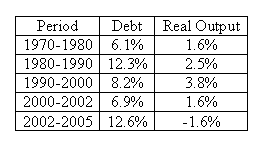Currently, there is an atmosphere of unreality pervading rural Australia. Land prices, particularly for beef properties are at an all time high. Numbers of farmers have become asset millionaires through acquisitions and rising land prices. These windfall capital gains, largely the consequence of a wider problem of asset inflation, are likely to generate a different perspective to rural assistance policies.
Past readiness of urban people to come to the aid of depressed rural industries is now clouded by urban water crises and a growing army of working poor. The April Reserve Bank of Australia Bulletin carries some sobering information that suggests rural leaders should be looking to a new policy direction for rural support programs. These sobering statistics, reminiscent of the early days of the disastrous 1990s, are contained in annualised growth rates of rural indebtedness and of real output.

Rural Data: Annualised % Rates of Change
Advertisement
The high growth years of debt between 1980 and 1990 appear to have re-emerged over the past three years. The difference this time is that real output has declined by 1.6 per cent compared to an expansion of 2.5 per cent during the 1980-90s. This decline in real output is from a combination of drought and environmental polices particularly the ban on land clearing.
Prior to the ban on land clearing, productivity and efficiency could be lifted through bringing undeveloped and under developed land into full production. This option is no longer available. Consequently, productivity and efficiency must be lifted through improved management techniques and technological advances. From the early picture emerging in the RBA data, reliance on improved management techniques and technological advances will not meet the performance improvements necessary to maintain real farm incomes.
The current situation is a little different to the early 1990s, but just as serious. Currently Australia is well into its third energy crisis and once again the Federal Government is unwilling to implement necessary policy changes. In 1990, on farm cost of diesel was 30.9 cents a litre. It depends on where it is bought currently, but is now about four times that cost. In 2006, energy prices are volatile and likely to rise even further over the medium term.
Interest rates are more favourable now than in the early 1990s. The RBA monetary policy instrument, the overnight cash rate, was 15.15 per cent in 1990; but, fell to 5.27 per cent by 1993. Although the indicator rate rose to 7.51 per cent by late 1996 and early 1997, monetary policy was easier through the 1990s.
Currently, the monetary policy instrument, overnight cash rate, is 5.75 per cent. The RBA is charged with the responsibility of a domestic inflationary target of 2-3 per cent rate. Fears of inflation suggest that monetary policy is likely to become tighter and this indicates an environment of uncertain interest rates.
A second significant interest rate factor is the current account deficit. In 1990, the current account deficit was 6.1 per cent of GDP. In 2005, the current account deficit was the 6.4 per cent of GDP. This made it the highest current account deficit since 1951-52 when it reached 14.2 per cent of GDP.
Advertisement
If the RBA wishes to hold the overall balance of payments position through capital inflow, it must maintain domestic interest competitively with international interest rates. Not to match international interest rates movements would suggest difficulty in attracting capital. In reality failure to match international interest rate movements could result in a capital outflow. Consequently, the Australian dollar would decline compounding the current account difficulty through rising offshore debt payments. The RBA is caught in a cleft stick.
The 1990 value of the AUD/US exchange rate was 78.9 cents. The value of the AUD/US exchange rate is currently above 75 cents and could threaten the 1990 value. While a policy decision to let the dollar depreciate would provide some relief to exporters, external debt payments rise and the current account deficit worsens. For a nation addicted to imports, export volumes would have to rise sufficiently to offset both increased debt payments and rising import costs. The RBA will have to balance its policy direction of domestic inflation, exchange rate stability and current account balance.
Major issues facing rural Australia therefore are: rising domestic and international transport costs, rising input costs, an uncertain interest rate environment and a relatively unpredictable exchange rate value. These financial factors are compounded by widespread drought and constraints on expansion to lift efficiency and productivity. Domestically, all these factors combine to threaten farm input costs, margins and viability. Given the thirst for debt indicated in the RBA April Bulletin, there are real storm clouds hanging over the farm sector and rural communities once again.
Current rural assistance programs comprising concessional interest rates and household support to low-income asset millionaires might come under hostile attack this time around. Urban-based groups looking for relief to pressing water crises are likely to look very differently at rural assistance programs. Representatives of the emerging army of working poor are also likely to view any rural crisis differently to past attitudes. Taxpayers could require some asset restructuring to self fund farmers through any future crisis.
It is time rural political representatives and the agro-political movement indicated some measure of concern over the economic environment facing rural Australia. They need to spell out policies early to maintain confidence in rural industries communities and regions.